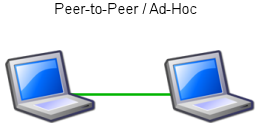Wireless LAN
Wireless LAN (WLAN) is a wireless computer network that links two or more devices using wireless communication to form a local area network (LAN) within a limited area such as a home, school, computer laboratory, campus, or office building. This gives users the ability to move around within the area and still be connected to the network.
Overview
A WLAN typically extends an existing wired local area network. WLANs are built by attaching a device called an access point (AP) to the edge of the wired network. Clients communicate with the AP using a wireless network adapter similar to an Ethernet adapter. The standard for WLANs is IEEE 802.11, which is commonly known as Wi-Fi.
History
The first wireless LAN was developed in 1971 at the University of Hawaii under the name ALOHAnet. The technology has since evolved significantly, with the introduction of the IEEE 802.11 standard in 1997, which has undergone several amendments to improve speed, security, and reliability.
Components
A typical WLAN consists of the following components:
- Access point (AP): A device that allows wireless devices to connect to a wired network using Wi-Fi.
- Wireless network interface controller (WNIC): A hardware device that connects a computer to a wireless network.
- Router: A device that forwards data packets between computer networks, creating an overlay internetwork.
Standards
The most common WLAN standard is IEEE 802.11, which includes several variations:
- IEEE 802.11a: Operates in the 5 GHz band and provides up to 54 Mbps.
- IEEE 802.11b: Operates in the 2.4 GHz band and provides up to 11 Mbps.
- IEEE 802.11g: Operates in the 2.4 GHz band and provides up to 54 Mbps.
- IEEE 802.11n: Operates in both 2.4 GHz and 5 GHz bands and provides up to 600 Mbps.
- IEEE 802.11ac: Operates in the 5 GHz band and provides up to several Gbps.
Security
WLANs are susceptible to various security threats, including eavesdropping, denial-of-service attacks, and man-in-the-middle attacks. To mitigate these risks, several security protocols have been developed:
- Wired Equivalent Privacy (WEP): An older security protocol that is now considered insecure.
- Wi-Fi Protected Access (WPA): An improved security protocol that addresses many of WEP's weaknesses.
- Wi-Fi Protected Access II (WPA2): A more secure version of WPA that uses Advanced Encryption Standard (AES).
Applications
WLANs are used in various applications, including:
- Home networks: Allowing multiple devices to connect to the internet and share resources.
- Enterprise networks: Providing wireless connectivity in office environments.
- Public hotspots: Offering internet access in public places such as cafes, airports, and libraries.
Related Pages
Categories
Transform your life with W8MD's budget GLP-1 injections from $125.
W8MD offers a medical weight loss program to lose weight in Philadelphia. Our physician-supervised medical weight loss provides:
- Most insurances accepted or discounted self-pay rates. We will obtain insurance prior authorizations if needed.
- Generic GLP1 weight loss injections from $125 for the starting dose.
- Also offer prescription weight loss medications including Phentermine, Qsymia, Diethylpropion, Contrave etc.
NYC weight loss doctor appointments
Start your NYC weight loss journey today at our NYC medical weight loss and Philadelphia medical weight loss clinics.
- Call 718-946-5500 to lose weight in NYC or for medical weight loss in Philadelphia 215-676-2334.
- Tags:NYC medical weight loss, Philadelphia lose weight Zepbound NYC, Budget GLP1 weight loss injections, Wegovy Philadelphia, Wegovy NYC, Philadelphia medical weight loss, Brookly weight loss and Wegovy NYC
|
WikiMD's Wellness Encyclopedia |
| Let Food Be Thy Medicine Medicine Thy Food - Hippocrates |
Medical Disclaimer: WikiMD is not a substitute for professional medical advice. The information on WikiMD is provided as an information resource only, may be incorrect, outdated or misleading, and is not to be used or relied on for any diagnostic or treatment purposes. Please consult your health care provider before making any healthcare decisions or for guidance about a specific medical condition. WikiMD expressly disclaims responsibility, and shall have no liability, for any damages, loss, injury, or liability whatsoever suffered as a result of your reliance on the information contained in this site. By visiting this site you agree to the foregoing terms and conditions, which may from time to time be changed or supplemented by WikiMD. If you do not agree to the foregoing terms and conditions, you should not enter or use this site. See full disclaimer.
Credits:Most images are courtesy of Wikimedia commons, and templates, categories Wikipedia, licensed under CC BY SA or similar.
Translate this page: - East Asian
中文,
日本,
한국어,
South Asian
हिन्दी,
தமிழ்,
తెలుగు,
Urdu,
ಕನ್ನಡ,
Southeast Asian
Indonesian,
Vietnamese,
Thai,
မြန်မာဘာသာ,
বাংলা
European
español,
Deutsch,
français,
Greek,
português do Brasil,
polski,
română,
русский,
Nederlands,
norsk,
svenska,
suomi,
Italian
Middle Eastern & African
عربى,
Turkish,
Persian,
Hebrew,
Afrikaans,
isiZulu,
Kiswahili,
Other
Bulgarian,
Hungarian,
Czech,
Swedish,
മലയാളം,
मराठी,
ਪੰਜਾਬੀ,
ગુજરાતી,
Portuguese,
Ukrainian
Contributors: Prab R. Tumpati, MD






